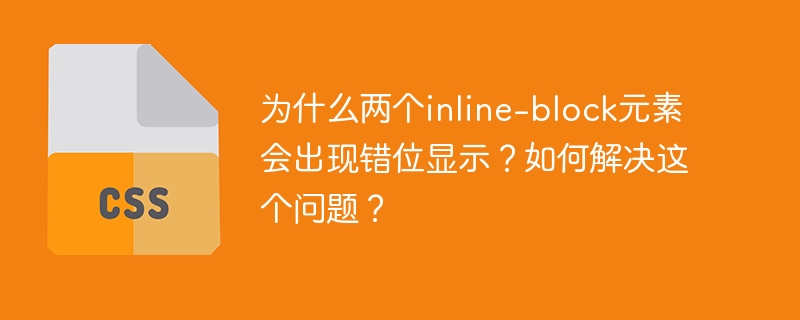 Web Front-end
Web Front-end
 CSS Tutorial
CSS Tutorial
 Why do two inline-block elements show misalignment? How to solve this problem?
Why do two inline-block elements show misalignment? How to solve this problem?
Why do two inline-block elements show misalignment? How to solve this problem?

Inline-block element misalignment problem: Causes and solutions
In web page layout, you can sometimes encounter headaches of misalignment problems when using inline-block elements. This article will explore its reasons in depth and provide effective solutions.
Problem phenomenon
When multiple inline-block elements are arranged, especially if one of the elements has overflow: hidden attribute, there may be misalignment in the vertical direction. This is particularly evident in some browsers or in specific CSS styles.
root cause
The root of the problem lies in the baseline alignment of the inline-block element. overflow: hidden attribute will affect the baseline position of the element, causing deviations when the subsequent inline-block elements are aligned with their baseline, resulting in misalignment.
Solution: Cleverly use vertical-align
The most effective solution is to use vertical-align attribute. By setting vertical-align: middle; (or other suitable vertical alignment), all inline-block elements can be forced to align with the same baseline to eliminate misalignment.
The following code example demonstrates how to solve the problem:
.list {
display: inline-block;
width: 80px;
height: 80px;
overflow: hidden;
vertical-align: middle; /*key code*/
}
.add {
display: inline-block;
width: 76px;
height: 76px;
color: #ccc;
border: 2px dashed;
transition: color .25s;
position: relative;
vertical-align: middle; /*key code*/
} By setting vertical-align: middle; for both .list and .add classes, they are aligned with the same vertical baseline, thus avoiding misalignment due to overflow: hidden . This is a simple and effective solution that works for most cases.
The above is the detailed content of Why do two inline-block elements show misalignment? How to solve this problem?. For more information, please follow other related articles on the PHP Chinese website!

Hot AI Tools

Undresser.AI Undress
AI-powered app for creating realistic nude photos

AI Clothes Remover
Online AI tool for removing clothes from photos.

Undress AI Tool
Undress images for free

Clothoff.io
AI clothes remover

AI Hentai Generator
Generate AI Hentai for free.

Hot Article

Hot Tools

Notepad++7.3.1
Easy-to-use and free code editor

SublimeText3 Chinese version
Chinese version, very easy to use

Zend Studio 13.0.1
Powerful PHP integrated development environment

Dreamweaver CS6
Visual web development tools

SublimeText3 Mac version
God-level code editing software (SublimeText3)

Hot Topics
 1359
1359
 52
52
 How to use bootstrap button
Apr 07, 2025 pm 03:09 PM
How to use bootstrap button
Apr 07, 2025 pm 03:09 PM
How to use the Bootstrap button? Introduce Bootstrap CSS to create button elements and add Bootstrap button class to add button text
 How to resize bootstrap
Apr 07, 2025 pm 03:18 PM
How to resize bootstrap
Apr 07, 2025 pm 03:18 PM
To adjust the size of elements in Bootstrap, you can use the dimension class, which includes: adjusting width: .col-, .w-, .mw-adjust height: .h-, .min-h-, .max-h-
 How to insert pictures on bootstrap
Apr 07, 2025 pm 03:30 PM
How to insert pictures on bootstrap
Apr 07, 2025 pm 03:30 PM
There are several ways to insert images in Bootstrap: insert images directly, using the HTML img tag. With the Bootstrap image component, you can provide responsive images and more styles. Set the image size, use the img-fluid class to make the image adaptable. Set the border, using the img-bordered class. Set the rounded corners and use the img-rounded class. Set the shadow, use the shadow class. Resize and position the image, using CSS style. Using the background image, use the background-image CSS property.
 How to upload files on bootstrap
Apr 07, 2025 pm 01:09 PM
How to upload files on bootstrap
Apr 07, 2025 pm 01:09 PM
The file upload function can be implemented through Bootstrap. The steps are as follows: introduce Bootstrap CSS and JavaScript files; create file input fields; create file upload buttons; handle file uploads (using FormData to collect data and then send to the server); custom style (optional).
 How to layout bootstrap
Apr 07, 2025 pm 02:24 PM
How to layout bootstrap
Apr 07, 2025 pm 02:24 PM
To use Bootstrap to layout a website, you need to use a grid system to divide the page into containers, rows, and columns. First add the container, then add the rows in it, add the columns within the row, and finally add the content in the column. Bootstrap's responsive layout function automatically adjusts the layout according to breakpoints (xs, sm, md, lg, xl). Different layouts under different screen sizes can be achieved by using responsive classes.
 How to verify bootstrap date
Apr 07, 2025 pm 03:06 PM
How to verify bootstrap date
Apr 07, 2025 pm 03:06 PM
To verify dates in Bootstrap, follow these steps: Introduce the required scripts and styles; initialize the date selector component; set the data-bv-date attribute to enable verification; configure verification rules (such as date formats, error messages, etc.); integrate the Bootstrap verification framework and automatically verify date input when form is submitted.
 How to view the date of bootstrap
Apr 07, 2025 pm 03:03 PM
How to view the date of bootstrap
Apr 07, 2025 pm 03:03 PM
Answer: You can use the date picker component of Bootstrap to view dates in the page. Steps: Introduce the Bootstrap framework. Create a date selector input box in HTML. Bootstrap will automatically add styles to the selector. Use JavaScript to get the selected date.
 How to set the bootstrap navigation bar
Apr 07, 2025 pm 01:51 PM
How to set the bootstrap navigation bar
Apr 07, 2025 pm 01:51 PM
Bootstrap provides a simple guide to setting up navigation bars: Introducing the Bootstrap library to create navigation bar containers Add brand identity Create navigation links Add other elements (optional) Adjust styles (optional)



